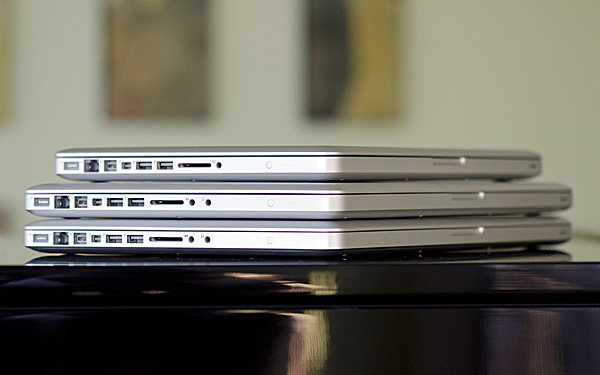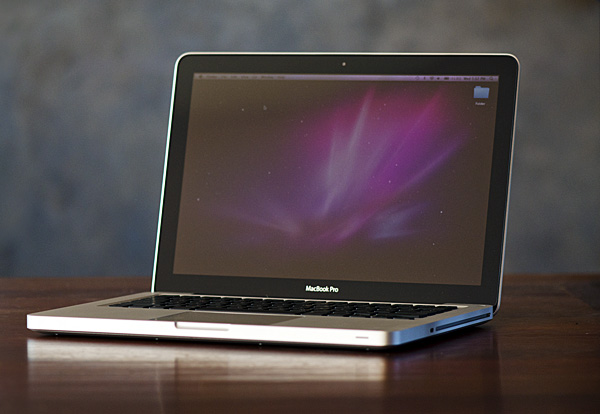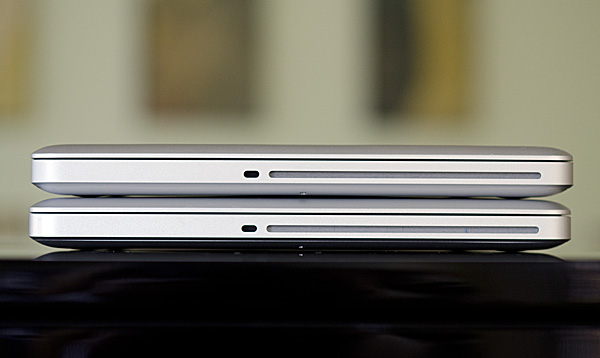The MacBook Pro Review (13 & 15-inch): 2011 Brings Sandy Bridge
by Anand Lal Shimpi, Brian Klug & Vivek Gowri on March 10, 2011 4:17 PM EST- Posted in
- Laptops
- Mac
- Apple
- Intel
- MacBook Pro
- Sandy Bridge
Last year at the iPad introduction Steve Jobs announced that Apple is a mobile device company. Just last week Steve returned to introduce the iPad 2 and point out that the majority of Apple's revenue now comes from products that run iOS. The breakdown is as follows:
| AAPL Revenue Sources—Q1 2011 | |||||||||
| iPad | iPhone | iPod | Mac | iTunes Store | Software/Services | Peripherals | |||
| Percentage | 17.2% | 39.1% | 12.8% | 20.3% | 5.4% | 2.9% | 2.2% | ||
Just looking at iPad and iPhone, that's 56% of Apple's sales. All Macs put together? Only 20%. Granted 20% of $26.7 billion in sales is still $5.3 billion, but the iOS crew gets most of the attention these days.
It shouldn't come as a surprise that when Apple launched its 2011 MacBook Pro lineup last week that it did so with little fanfare. There was no special press event and no video of an unusually charismatic man on a white background describing the latest features of the systems. All we got two weeks ago were a few pages describing the high level features of the lineup, a short outage on the Mac Store and five new configurations available for sale.

Apple tends to not mix architecture updates and chassis changes. The 2011 MacBook Pro lineup is no different. These models fundamentally implement the same updated unibody shell that was introduced in 2009. The term unibody comes from the fact that the base of the chassis is machined out of a single block of aluminum. There's no way to gain access to the MacBook Pro's internals from above, you have to go in from below. As a result there's absolutely no chassis flex or squeaking while you pound on the keyboard, use the trackpad or just interact with the part of the machine that you're most likely to be touching. Apple has been shipping unibody MacBook Pros since 2008 and from my experience the design has held up pretty well.

From top to bottom: 13-inch MBP (2011), 15-inch MBP (2011), 15-inch MBP (2010)
The biggest letdown in the design has been the hinge connecting the display to the rest of the chassis. I haven't had it fail completely but I've had it become frustratingly loose. Even brand new, out of the box, the 15-inch MacBook Pro will have its display move by a not insignificant amount if you tilt the machine 90 degrees so that the display is parallel to the ground. A number of readers have written me over the years asking if Apple has improved the locking ability of the hinge in each new version of the MacBook Pro. It doesn't seem to be any better with the 2011 model—sorry guys.
Other than screen size, ports and internals, there's nothing that separates the 13-, 15- and 17-inch MacBook Pros from one another. They all feature the same excellent backlit keyboard (keyboard size is constant across all models) and a variant of the same high quality display. All of them have the same front facing 720p camera and the same large glass-covered trackpad.
Battery capacity hasn't changed compared to last year, although power consumption on some models has gone up (more on this later).
| 2011 MacBook Pro Lineup | |||||||
| 13-inch (low end) | 13-inch (high end) | 15-inch (low end) | 15-inch (high end) | 17-inch | |||
| Dimensions |
0.95 H x 12.78 W x 8.94 D
|
0.95 H x 14.35 W x 9.82 D
|
0.98 H x 15.47 W x 10.51 D
|
||||
| Weight |
4.5 lbs (2.04 kg)
|
5.6 lbs (2.54 kg)
|
6.6 lbs (2.99 kg)
|
||||
| CPU |
2.3 GHz dual-core Core i5
|
2.7 GHz dual-core Core i7
|
2.0 GHz quad-core Core i7
|
2.2 GHz quad-core Core i7
|
2.2 GHz quad-core Core i7
|
||
| GPU |
Intel HD 3000 Graphics
|
Intel HD 3000 + AMD Radeon HD 6490M (256MB)
|
Intel HD 3000 + AMD Radeon HD 6750M (1GB)
|
Intel HD 3000 + AMD Radeon HD 6750M (1GB)
|
|||
| RAM |
4GB 1333MHz DDR3 (8GB max)
|
||||||
| HDD |
320GB 5400 RPM
|
500GB 5400 RPM
|
500GB 5400 RPM
|
750GB 5400 RPM
|
750GB 5400 RPM
|
||
| Display Resolution |
1280x800
|
1440x900 (1680x1050 optional)
|
1920x1200
|
||||
| Ports |
Gigabit LAN, Firewire 800, Thunderbolt, 2x USB 2.0, SDHC slot, combined audio in/out jack
|
Gigabit LAN, Firewire 800, Thunderbolt, 2x USB 2.0, SDHC slot, separate audio in/out jacks
|
Gigabit LAN, Firewire 800, Thunderbolt, 3x USB 2.0, separate audio in/out jacks, ExpressCard 34 slot
|
||||
| Battery Capacity |
63.5Wh
|
77.5Wh
|
95Wh
|
||||
| Price | $1,199 | $1,499 | $1,799 | $2,199 | $2,499 | ||
The new MacBook Pros are still equipped with DVD drives and thus Apple still distributes OS X and the application preload on a pair of DVDs. I was hoping Apple would go to an all-USB distribution starting with the MBA but it looks like we'll have to wait for another generation of Pro systems before we see that.












198 Comments
View All Comments
IntelUser2000 - Friday, March 11, 2011 - link
You don't know that, testing multiple systems over the years should have shown performance differences between manufacturers with identical hardware is minimal(<5%). Meaning its not Apple's fault. GPU bound doesn't mean rest of the systems woud have zero effect.It's not like the 2820QM is 50% faster, its 20-30% faster. The total of which could have been derived from:
1. Quad core vs. Dual core
2. HD3000 in the 2820QM has max clock of 1.3GHz, vs. 1.2GHz in the 2410M
3. Clock speed of the 2820QM is quite higher in gaming scenarios
4. LLC is shared between CPU and Graphics. 2410M has less than half the LLC of 2820QM
5. Even at 20 fps, CPU has some impact, we're not talking 3-5 fps here
It's quite reasonable to assume, in 3DMark03 and 05, which are explicitely single threaded, benefits from everything except #1, and frames should be high enough for CPU to affect it. Games with bigger gaps, quad core would explain to the difference, even as little as 5%.
JarredWalton - Friday, March 11, 2011 - link
I should have another dual-core SNB setup shortly, with HD 3000, so we'll be able to see how that does.Anyway, we're not really focusing on 3DMarks, because they're not games. Looking just at the games, there's a larger than expected gap in the performance. Remember: we've been largely GPU limited with something like the GeForce G 310M using Core i3-330UM ULV vs. Core i3-370. That's a doubling of clock speed on the CPU, and the result was: http://www.anandtech.com/bench/Product/236?vs=244 That's a 2 to 14% difference, with the exception of the heavily CPU dependent StarCraft II (which is 155% faster with the U35Jc).
Or if you want a significantly faster GPU comparison (i.e. so the onus is on the CPU), look at the Alienware M11x R2 vs. the ASUS N82JV: http://www.anandtech.com/bench/Product/246?vs=257 Again, much faster GPU than the HD 3000 and we're only seeing 10 to 25% difference in performance for low detail gaming. At medium detail, the difference between the two platforms drops to just 0 to 15% (but it grows to 28% in BFBC2 for some reason).
Compare that spread to the 15 to 33% difference between the i5-2415M and the i7-2820QM at low detail, and perhaps even more telling is the difference remains large at medium settings (16.7 to 44% for the i7-2820QM, except SC2 turns the tables and leads by 37%). The theoretical clock speed difference on the IGP is only 8.3%, and we're seeing two to four times that much -- the average is around 22% faster, give or take. StarCraft II is a prime example of the funkiness we're talking about: the 2820QM is 31% faster at low, but the 2415M is 37% faster at medium? That's not right....
Whatever is going on, I can say this much: it's not just about the CPU performance potential. I'll wager than when I test the dual-core SNB Windows notebook (an ASUS model) that scores in gaming will be a lot closer than what the MBP13 managed. We'll see....
IntelUser2000 - Saturday, March 19, 2011 - link
I forgot one more thing. The quad core Sandy Bridge mobile chips support DDR3-1600 and dual core ones only up to DDR3-1333.mczak - Thursday, March 10, 2011 - link
memory bus width of HD6490M and H6750M is listed as 128bit/256bit. That's quite wrong, should be 64bit/128bit.btw I'm wondering what's the impact on battery life for the HD6490M? It isn't THAT much faster than the HD3000, so I'm wondering if at least the power consumption isn't that much higher neither...
Anand Lal Shimpi - Thursday, March 10, 2011 - link
Thanks for the correction :)Take care,
Anand
gstrickler - Thursday, March 10, 2011 - link
Anand, I would like to see heat and maximum power consumption of the 15" with the dGPU disabled using gfxCardStatus. For those of us who aren't gamers and don't need OpenCL, the dGPU is basically just a waste of power (and therefore, battery life) and a waste of money. Those should be fairly quick tests.Nickel020 - Thursday, March 10, 2011 - link
The 2010 Macbooks with the Nvidia GPUs and Optimus switch to the iGPU again even if you don't close the application, right? Is this a general ATI issue that's also like this on Windows notebooks or is it only like this on OS X? This seems like quite an unnecessary hassle, actually having to manage it yourself. Not as bad as having to log off like on my late 2008 Macbook Pro, but still inconvenient.tipoo - Thursday, March 10, 2011 - link
Huh? You don't have to manage it yourself.Nickel020 - Friday, March 11, 2011 - link
Well if you don't want to use the dGPU when it's not necessary you kind of have to manage it yourself. If I don't want to have the dGPU power up while web browsing and make the Macbook hotter I have to manually switch to the iGPU with gfxCardStatus. I mean I can leave it set to iGPU, but then I will still manually have to switch to the dGPU when I need the dGPU. So I will have to manage it manually.I would really have liked to see more of a comparison with how the GPU switching works in the 2010 Macbook Pros. I mean I can look it up, but I can find most of the info in the review somewhere else too; the point of the review is kind of to have it all the info in one place, and not having to look stuff up.
tajmahal42 - Friday, March 11, 2011 - link
I think switching behaviour should be exactly the same for the 2010 and 2011 MacBook Pros, as the switching is done by the Mac OS, not by the Hardware.Apparently, Chrome doesn't properly close done Flash when it doesn't need it anymore or something, so the OS thinks it should still be using the dGPU.